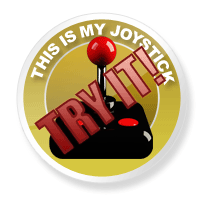Reviews
Nintendo 3DS
April 4, 2011, Author: James Sheppard
Nintendo have always been the indisputable leaders of the handheld gaming market since the very first Gameboy Classic, and here they are yet again, ushering in the next generation of portable consoles with the Nintendo 3DS. Continuing on from the popularity of the first DS, the 3DS has two screens, one of them a touch screen, but as you’ll undoubtedly know by now, the real exciting development here is in its three-dimensional graphics that don’t even require glasses.
There is a lot riding on the release of this console, with the impressive-looking Sony NGP out later this year. Nintendo has to make an impact with the 3DS and use its earlier release to its advantage, to ensure that they continue their domination of the market. The continual evolution of mobile phones is also a concern, as the iPhone and Android platforms continue to spit out their deluge of portable games, which set the consumer back no more than a few quid at a time.
Enter a new dimension
Any readers who haven’t experienced the 3DS for themselves will, of course, be itching to hear about its 3D capabilities first of all. Well, it’s too bad… you can wait. Nah, I’m not really that mean. The 3D function is directly controlled by a slider on the right side of the top screen, gradually altering the output from eye-popping 3D to entirely flat 2D. This is a stroke of genius, as all preferences are catered for, ready to select on the fly. It also means that the unfortunate few percent of the population who can’t process 3D images aren’t left out in the cold.
The effect is different in nature to what I was expecting, and perhaps what many others may have assumed also. Instead of appearing like a holograph projected out of the screen, the 3DS in fact works in an entirely opposite direction. Whereas there is definitely an illusion of some objects popping out slightly, the major impression here is of a great depth that extends right back into the screen, as if you were peering through a window. This is very exciting to see for the first time (although your reaction may not be quite as cheesy as portrayed on the current Nintendo television adverts), as the effect is entirely a trick of the eyes, with no burden of 3D glasses necessary.
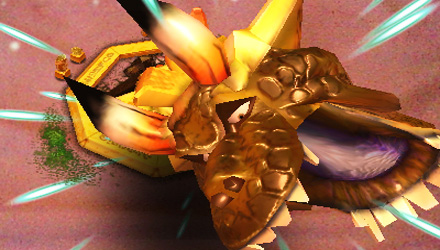
Not quite the same when it doesn't look like it's coming out of the screen to bite your face off, but you get the idea. (AR Games)
The effect works by projecting two different images at once and letting your eyes line them up to create a clever mirage. The downside to this method is that you have to be positioned in exactly the right place for these images to line up correctly, otherwise you’ll see a blurry, ghosted mess. Reports from sources who’ve tried a variety of games suggest that some employ the effect better than others, and that they vary in the broadness of the 3D ‘sweet spot’. So far I own Super Street Fighter IV: 3D and the built-in software, and these are reasonably forgiving in general, even on the full 3D setting. A brief test of Pilotwings: Resort, however, seemed to indicate that it was a little trickier to get it right.
An important question is if the effect is merely a charming boost to the graphics, or if it actually affects gameplay. So far, it is definitely more of the former than the latter. The main exception to this rule is that in Pilotwings and the new 3D over-the-shoulder perspective on Street Fighter. 3D helps you to perceive depth slightly more effectively to better judge your flying and punching, respectively. The main caveat of the slider that I mentioned earlier, is that all titles must be fully playable in 2D without too much disadvantage. As a result, disappointingly, there may not be many games that actually use the potential of 3D to its absolute fullest.
Finally, there are concerns over the repercussions of the 3D effect. Children under six years old must not play the console in anything other than 2D mode, to avoid damaging the development of their eyesight. To add to this, there are already stories on the Internet of people experiencing dizziness, headaches and even physical sickness from playing the 3DS. This is unfortunate, however neither myself, nor anyone I’ve let use my console, has experienced any issues whatsoever.
Let’s get physical
The 3DS at launch is available in two models, Cosmos Black and Aqua Blue. Feeling adventurous, I plumped for the latter, which is actually a combination of four different colours: three different shades of blue, and a black inner on the top half. Little details like flecks of glitter, and a slight gradient to the colour on the top of the unit, are nice touches and all add up to the console being pretty easy on the eyes.
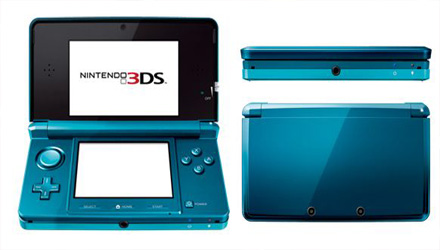
Phwoar.
Little has changed to the general design since the last generations of DS, with some of the main alterations including a lack of a Gameboy Advance slot, motion sensors, two outer cameras to facilitate taking 3D photos and a (very welcome) analogue nub. Unusually, the screens are also of a mismatched size; the 3D screen on the top is 3 1/2 inches whereas the bottom touch screen is just 3 inches. These are a little paltry when compared to the DSi XL, and something to watch out for in the inevitable revisions of the 3DS.
The console feels reassuringly solid in the hands and gives the impression of a decent build quality. The lid moves securely on its hinges, the SD slot slid is surprisingly well-attached to the body, and the majority of the buttons are responsive. The only issue I’ve had is with the D-pad, which has on occasions creaked and even momentarily stuck, leading to screams of rage on Street Fighter online.
The graphical prowess of the handheld is reasonable, with excellent screens that ooze colour and clarity into your eye sockets. That said, the visuals fall short of breathtaking and will probably look a little dated when the release of the NGP rolls along. It’s usually the case though that when developers truly get to grips with a console, they can squeeze out some more impressive graphics than previously achieved on the launch titles, so that’s something to look forward to. It’s also important to bear in mind that the console’s 3D effect arguably adds to its visual beauty.
Something that I didn’t expect to blow me away was the quality of sound emanating from the discrete built-in speakers; however, to say I’m pleasantly surprised would be an understatement. The volume is more than generous as long as you aren’t playing in a noisy environment, and the clarity is by far the best I’ve heard from any handheld console to date.
Not everything is rosy, however. One of the largest bugbears of the system is its pathetic battery life. In general you can expect around three hours playtime before you’re scrambling for a charger, or in the worse case scenario, left out and about without anything to do. This is due to the two bright screens, one of which effectively displays two images at once, and the more powerful hardware built-in. I’m one of those shut-ins who often plays their ‘portable’ consoles indoors more than I do outside, so it doesn’t affect me too much, although I imagine that there are a lot of people for whom this would be barely fit for purpose.
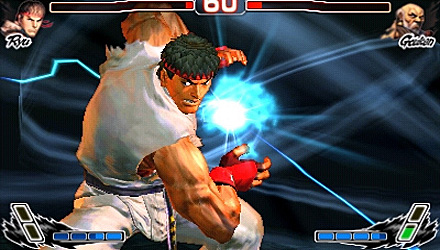
HADOU...Warning: battery low
As a small apology, Nintendo have included a charging dock as standard with every unit. This does the job, although it’s obvious that all expense was spared here, with the accessory feeling generally cheap and tacky and not always activating every time you pop the console in. The battery issue is another element that is almost certain to be improved in the next 3DS design.
Pick it up, play it, then pocket it
The operating system and its interface thankfully knock the previous DS generations out of the park. The user interface is strongly reminiscent of the Wii, and is all the better for it. Application shortcuts can be rearranged at will and everything is within easy reach. My only minor gripe is that it can sometimes take a few seconds to load and close each application, which can feel a little slow compared to smartphones.
Press the ‘Home’ button whilst playing with an app or game, and a menu appears, allowing you to return to the main 3DS interface easily and change application if you wish. There is no multitasking, but I really wouldn’t see the point personally. It’s welcome enough to be able to switch between tasks so intuitively.
Since the dawn of time, or of handheld gaming at least, Nintendo has always provided one step back of backwards compatibility. The 3DS is no exception, doing away with Gameboy Advance functionality but happily running all DS games you throw at it. I haven’t had any emulation problems so far on the games I’ve tested, however they can look a little stretched and washed-out on the 3DS screen, sadly.
Nintendo has a history of wrapping its fans in cotton wool where the Internet is concerned, requiring the trade of irritating friend codes for every single game and generally restricting communication as much as possible. The situation is improved on the 3DS, with only one Friend Code required for your console, replacing the need for one with every game. A friends list shows which of your friends are online and their current game, letting you catch your mate out when he’s playing Barbie’s Horse Adventures 3D. The social aspect is still leagues behind something like Xbox Live, but it’s a step in the right direction.
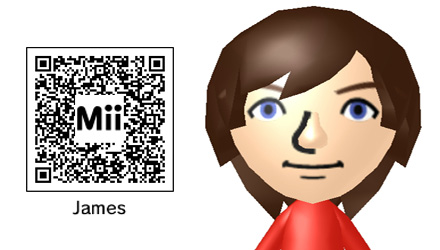
If you have a 3DS and would like my Mii (which naturally, you would) then scan this QR code and he's all yours.
One exciting new social feature is Streetpass, a component that operates silently, whilst the 3DS is sleeping in your pocket. Walk past another 3DS owner, and you’ll wirelessly trade data, giving you some nice surprises when you next open up the console. You’ll share your favourite Mii, and Streetpass-compatible games will interact, even if they’re not currently in your console. Nintendogs will trade your doggy photos, and Street Fighter will initiate battles between collectable figurines.
Another reason to go out into the great outdoors is the inbuilt pedometer, which awards you with Play Coins for walking. These Play Coins can be spent to buy new levels and features in the preloaded software, and in Street Fighter, you can purchase figures to add to your collection. I’m looking forward to seeing more inventive uses of the currency, as it’s a fantastic idea. Who said gamers were lazy? Oh wait, you can just sit there on your arse, and shake it to fool the pedometer? Bummer.
Thinking inside of the box
If you can’t decide which game(s) to buy with your console straight away don’t fret, because the 3DS comes preloaded with a bountiful supply of apps and mini games to keep your idle thumbs occupied, for now. Just don’t expect to be playing all of them for months to come.
First up are the Augmented Reality Games, which make use of the included AR Cards. Place these on a flat surface and the console will detect them through the camera, transforming your coffee table into a 3D target range, dragon lair or even a fishing pond. These are all fun little tech demos that are a good showcase of the system, and make you wonder how full games could use this function in the future. The only issue is that, once again, this is a portable gaming device; positioning cards on the seat next to you on the Tube and running around them to get a better shot is going to (quite rightly) earn you some funny looks…
Face Raiders is next in line, and in my opinion is the strongest offering out of all the bundled software. Take photos of yourself, family members or the dog, and these will be transformed into flying enemies that whizz around and generally cause havoc. This is hilarious good fun, exuding charm as familiar faces wink and blow kisses, then laugh malevolently as they transform into the end-of-level boss. Moving the console around aims the crosshair, courtesy of the accelerometer and gyroscope built-in. You’ll have to turn right around, or even look all of the way up, to locate all of the enemies. As you can imagine, this is once again something that will make you look like a bit of a dick, if you’re playing it in public.
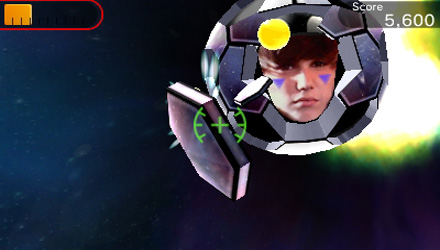
Baby, baby, baby, OW! Face Raiders cleverly detects faces from picture files. Justin Bieber has never been so entertaining
The Mii Creator is all present and correct from the Wii, operating in a very similar manner to before. This used to provide me with hours of entertainment, recreating celebrities and offensive caricatures of people I knew; you are only limited by your creativity. The Mii Creator is tied into the Mii Plaza app, a socially-oriented destination that is the hub for Miis being shared through Streetpass. Here you will find Miis that have arrived from any other 3DS consoles you walked passed, and can choose to add them to your collection if you wish. As a bonus, you can also use them to take part in two mini-games, a jigsaw puzzle and a simplistic RPG.
The Camera application itself can’t really be faulted, coming equipped with all sorts of daft filter effects, manual controls of brightness and contrast, a timer and even the deeply disturbing ability to merge two faces together. What lets this down entirely is the inexcusably poor quality of the 3DS’ cameras. 0.3 megapixels… let that sink in for a second. Even mobile phones these days generally vary between 5 and 10 MP. Resolution isn’t the be-all and end-all of image quality as marketing may have you believe, but the cameras are just bad through and through, producing photos hampered with blur, grain and low contrast.
When viewed as no more than a casual toy, you really can have some fun taking pictures on the 3DS. Two files are saved each time; one is a 3D image viewable on your console, and the second is a regular JPG, so all bases are covered here. It’s just a shame that the inadequate hardware stops this function short of being something truly special.
The Sound application is another program that is self-explanatory in its use. From here you can play music, share data over Streetpass and make your own recordings. The best bit is that these can be manipulated; I had a whale of a time recording Florence and the Machine and changing the speed and pitch, varying her sound between a male opera singer and a Disney chipmunk.
Last, and probably in all honesty, least, the Activity Log app records every single thing you do on the console, in minute detail. The number of times each app is played, the overall playtime, and even the total amount of steps taken/console shakes… Nintendo really have thought of everything here, to the point of being obsessive. In fairness, it’s all quite interesting to take a look at now and then; I just hope my 3DS doesn’t end up with months of no activity at a time, like my Wii did…
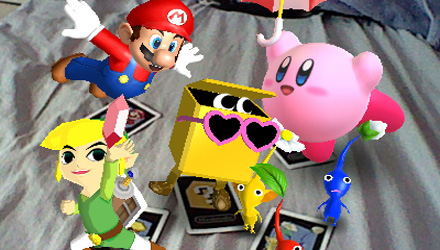
Star Pics is an AR Game that lets you pose Nintendo characters around your house using the AR cards. Now Pikmin in your garden and Link in your basement can be a (augmented) reality.
Overall then, the 3DS really is stuffed to the brim with quality preloaded software, and I haven’t even mentioned the notifications, built-in manuals and Game Notes features. Disappointingly, two of arguably the most desirable applications are missing at launch, the eStore and Web Browser. The former in particular really is a missed opportunity, considering the fact that there obviously isn’t a huge range of retail games to choose from yet.
Ninten-do, or Ninten-don’t?
Well, hopefully by now you’ve gained an in-depth perception of Nintendo’s new baby. 3D without glasses really is as good as it was hyped up to be; the console is sleek and sexy; it comes with a range of software as standard and it gushes with that unique Nintendo charm. Surely, there’s not a lot standing in your way of a guaranteed purchase?
Sadly, there are several drawbacks to take into account. First of all, the 3DS doesn’t come cheap. The RRP is set at a hefty £229, although it is quite easily available at around the £180 mark. This is still a decent increase over the £130 RRP of the original DS, and isn’t helped by the retail game price increase from £29.99 to £39.99. Due to the more advanced hardware, many games are costing two or three times as much to develop, and these costs have to be recouped somewhere, unfortunately.
Augmented Reality is a brilliant feature, as is the motion control seen in Face Raiders, although the impracticality and embarrassment of playing these in public, coupled with the console’s atrocious battery life, create the irony of a portable games console that isn’t actually that portable.
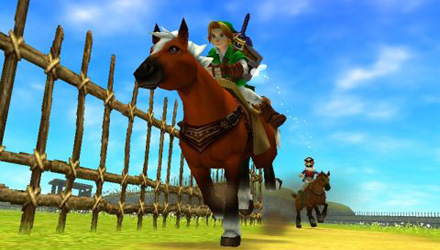
So close and yet, so far... expect this masterpiece to make its comeback around June.
The launch list is of an acceptable quality, but true killer apps like Mario and Zelda are absent, as are some important features like the 3DS eStore. This means that for some, it may be better waiting it out until more enticing offerings are available, or even until the console’s first revision, when some of the issues will undoubtedly be improved.
It still goes without saying that the Nintendo 3DS is a brilliant, innovative bit of kit, and I don’t regret buying mine for a second. Several niggles here and there, and a sizeable hit to your wallet mean that you just may wish to hold back on a purchase for now. The possibility of issues arising from the use of the 3D function is also a reason that you should get down to your local game retailer, and try it out for yourself.
Platforms: 3DS, Product Reviews | Tagged 3ds, Augmented Reality, Console, DS, Face Raiders, Gameboy, Gyroscope, Handheld, Mario, Mii, Motion Control, NGP, Nintendo, Pilotwings: Resort, Pokemon, portable, Street Fighter IV: 3D, Touchscreen, Wii, Zelda


